POG340: Risk Management & Innovation - BP PLC in the Oil & Gas
VerifiedAdded on 2023/06/10
|14
|3203
|392
Report
AI Summary
This report explores the significance of risk management and innovation, focusing on BP PLC. It introduces the Pinwheel rotation procedure and its applicability to BP PLC, a leading oil and gas company, detailing an action framework for risk management. The study examines the role of strategic risk management in successfully implementing innovation, emphasizing risk analysis and mitigation strategies. It also references MassMutual to contrast strategic planning approaches. The report includes diagrams illustrating risk management processes and project execution, and it concludes by assessing strategic performance and identifying risks related to reporting and compliance.
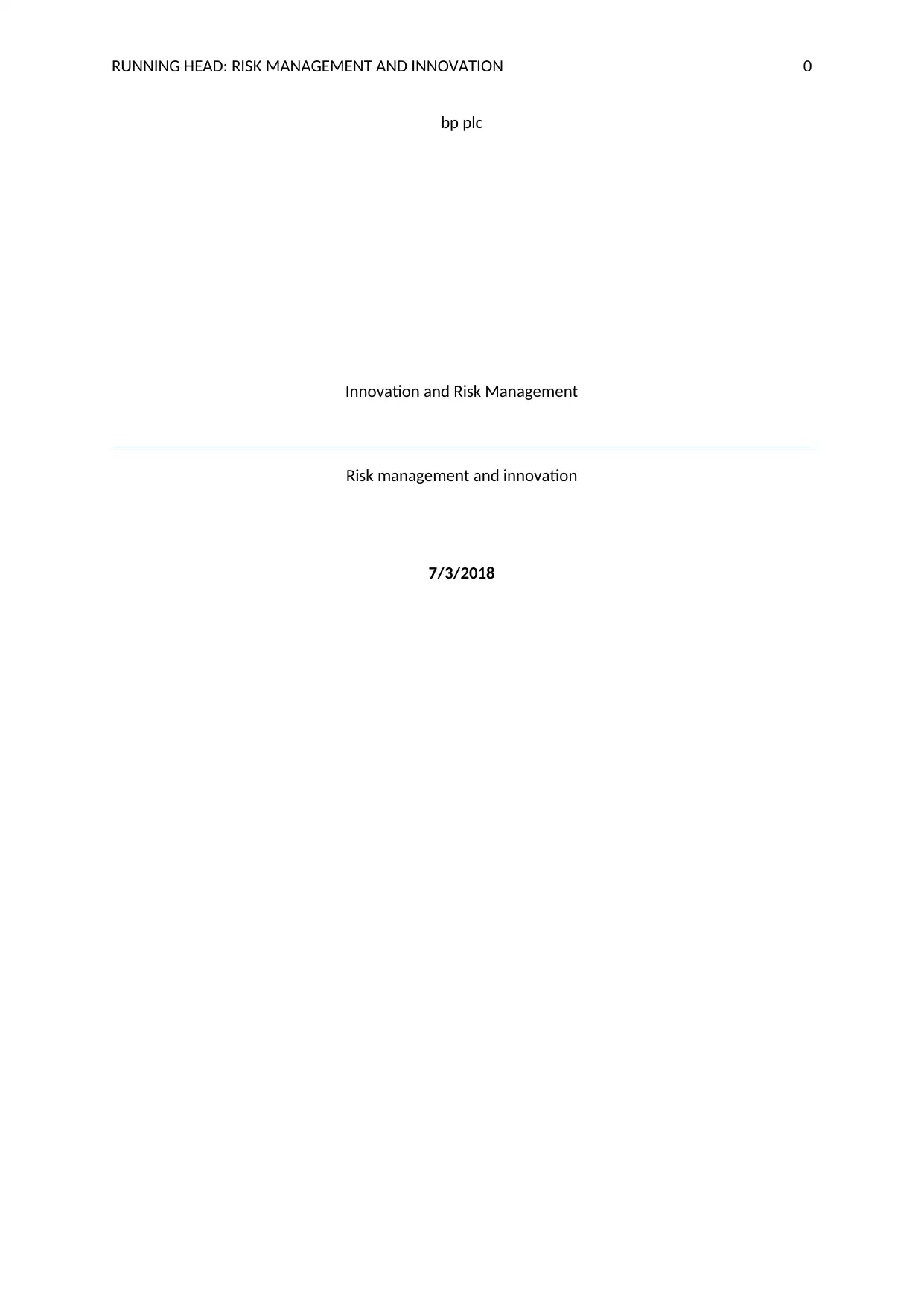
RUNNING HEAD: RISK MANAGEMENT AND INNOVATION 0
bp plc
Innovation and Risk Management
Risk management and innovation
7/3/2018
bp plc
Innovation and Risk Management
Risk management and innovation
7/3/2018
Paraphrase This Document
Need a fresh take? Get an instant paraphrase of this document with our AI Paraphraser
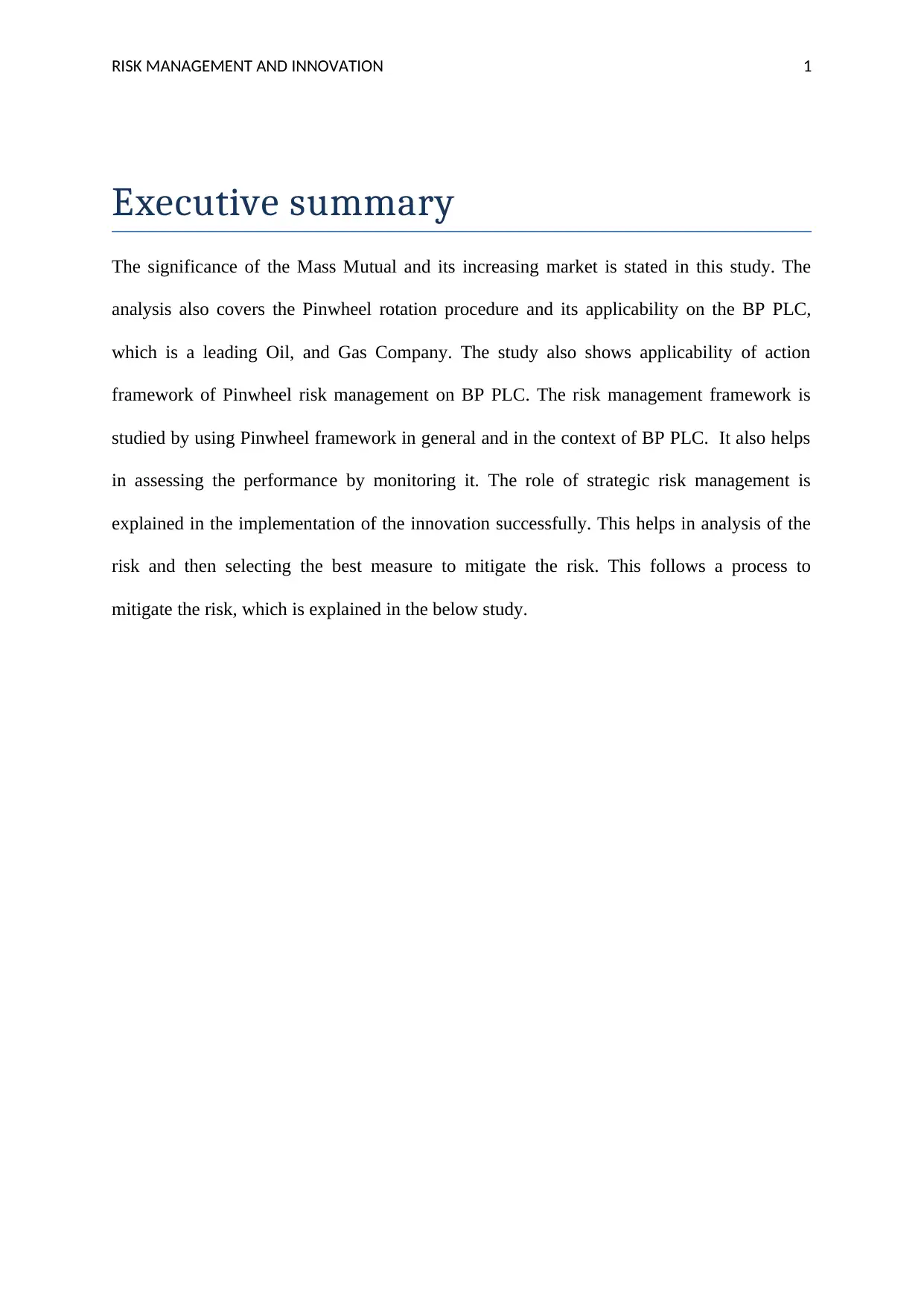
RISK MANAGEMENT AND INNOVATION 1
Executive summary
The significance of the Mass Mutual and its increasing market is stated in this study. The
analysis also covers the Pinwheel rotation procedure and its applicability on the BP PLC,
which is a leading Oil, and Gas Company. The study also shows applicability of action
framework of Pinwheel risk management on BP PLC. The risk management framework is
studied by using Pinwheel framework in general and in the context of BP PLC. It also helps
in assessing the performance by monitoring it. The role of strategic risk management is
explained in the implementation of the innovation successfully. This helps in analysis of the
risk and then selecting the best measure to mitigate the risk. This follows a process to
mitigate the risk, which is explained in the below study.
Executive summary
The significance of the Mass Mutual and its increasing market is stated in this study. The
analysis also covers the Pinwheel rotation procedure and its applicability on the BP PLC,
which is a leading Oil, and Gas Company. The study also shows applicability of action
framework of Pinwheel risk management on BP PLC. The risk management framework is
studied by using Pinwheel framework in general and in the context of BP PLC. It also helps
in assessing the performance by monitoring it. The role of strategic risk management is
explained in the implementation of the innovation successfully. This helps in analysis of the
risk and then selecting the best measure to mitigate the risk. This follows a process to
mitigate the risk, which is explained in the below study.
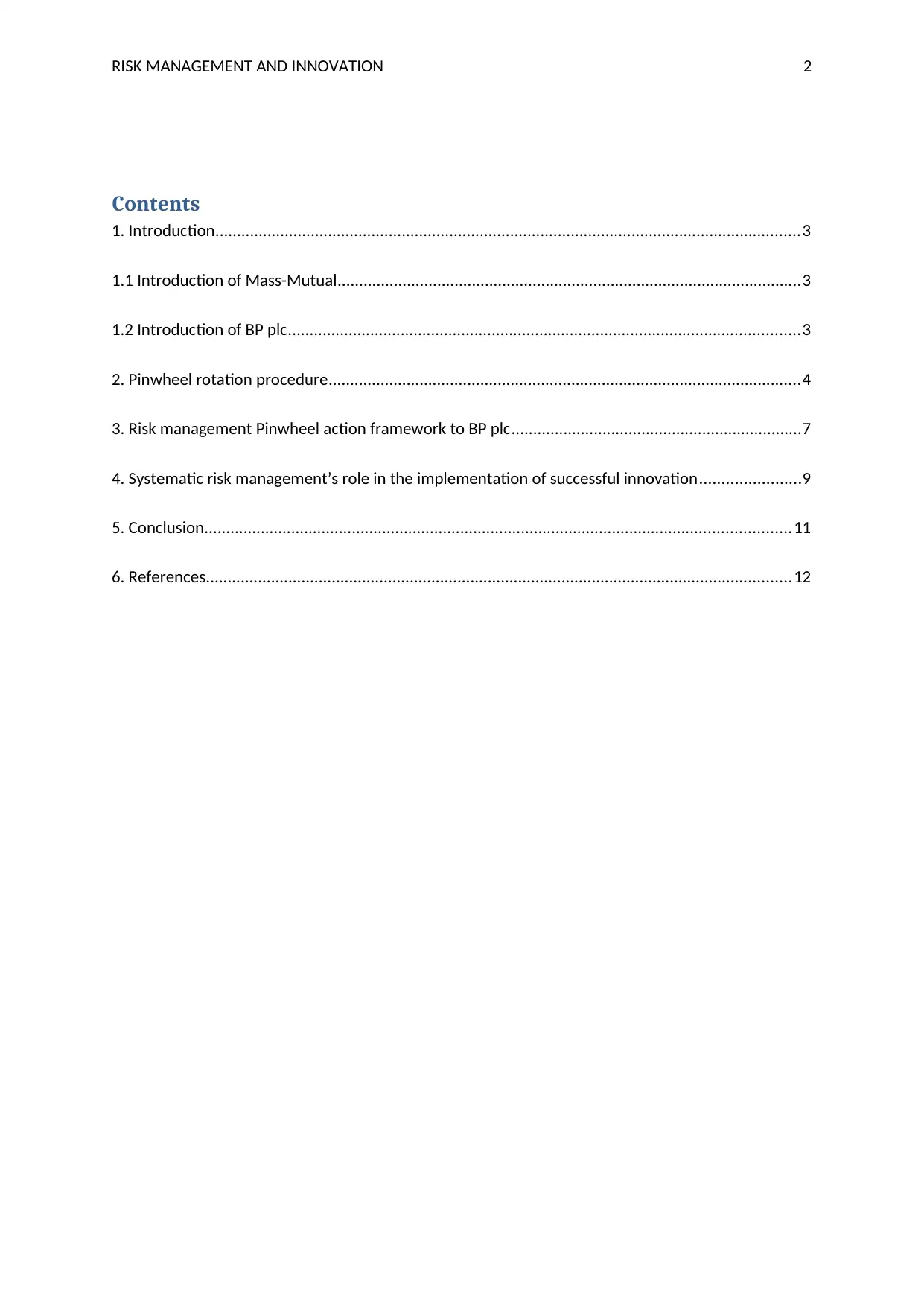
RISK MANAGEMENT AND INNOVATION 2
Contents
1. Introduction.......................................................................................................................................3
1.1 Introduction of Mass-Mutual...........................................................................................................3
1.2 Introduction of BP plc......................................................................................................................3
2. Pinwheel rotation procedure.............................................................................................................4
3. Risk management Pinwheel action framework to BP plc...................................................................7
4. Systematic risk management’s role in the implementation of successful innovation.......................9
5. Conclusion.......................................................................................................................................11
6. References.......................................................................................................................................12
Contents
1. Introduction.......................................................................................................................................3
1.1 Introduction of Mass-Mutual...........................................................................................................3
1.2 Introduction of BP plc......................................................................................................................3
2. Pinwheel rotation procedure.............................................................................................................4
3. Risk management Pinwheel action framework to BP plc...................................................................7
4. Systematic risk management’s role in the implementation of successful innovation.......................9
5. Conclusion.......................................................................................................................................11
6. References.......................................................................................................................................12
⊘ This is a preview!⊘
Do you want full access?
Subscribe today to unlock all pages.

Trusted by 1+ million students worldwide
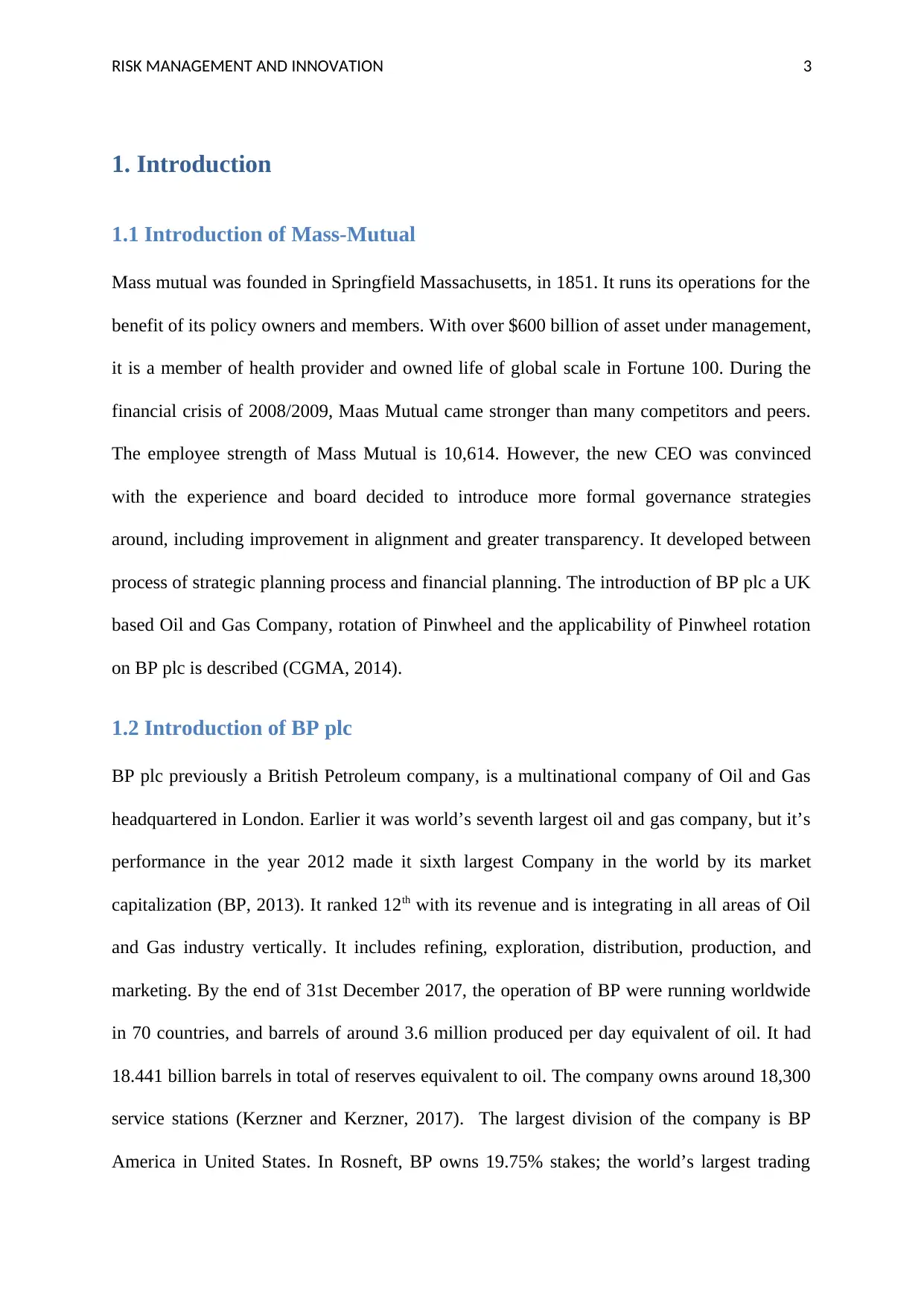
RISK MANAGEMENT AND INNOVATION 3
1. Introduction
1.1 Introduction of Mass-Mutual
Mass mutual was founded in Springfield Massachusetts, in 1851. It runs its operations for the
benefit of its policy owners and members. With over $600 billion of asset under management,
it is a member of health provider and owned life of global scale in Fortune 100. During the
financial crisis of 2008/2009, Maas Mutual came stronger than many competitors and peers.
The employee strength of Mass Mutual is 10,614. However, the new CEO was convinced
with the experience and board decided to introduce more formal governance strategies
around, including improvement in alignment and greater transparency. It developed between
process of strategic planning process and financial planning. The introduction of BP plc a UK
based Oil and Gas Company, rotation of Pinwheel and the applicability of Pinwheel rotation
on BP plc is described (CGMA, 2014).
1.2 Introduction of BP plc
BP plc previously a British Petroleum company, is a multinational company of Oil and Gas
headquartered in London. Earlier it was world’s seventh largest oil and gas company, but it’s
performance in the year 2012 made it sixth largest Company in the world by its market
capitalization (BP, 2013). It ranked 12th with its revenue and is integrating in all areas of Oil
and Gas industry vertically. It includes refining, exploration, distribution, production, and
marketing. By the end of 31st December 2017, the operation of BP were running worldwide
in 70 countries, and barrels of around 3.6 million produced per day equivalent of oil. It had
18.441 billion barrels in total of reserves equivalent to oil. The company owns around 18,300
service stations (Kerzner and Kerzner, 2017). The largest division of the company is BP
America in United States. In Rosneft, BP owns 19.75% stakes; the world’s largest trading
1. Introduction
1.1 Introduction of Mass-Mutual
Mass mutual was founded in Springfield Massachusetts, in 1851. It runs its operations for the
benefit of its policy owners and members. With over $600 billion of asset under management,
it is a member of health provider and owned life of global scale in Fortune 100. During the
financial crisis of 2008/2009, Maas Mutual came stronger than many competitors and peers.
The employee strength of Mass Mutual is 10,614. However, the new CEO was convinced
with the experience and board decided to introduce more formal governance strategies
around, including improvement in alignment and greater transparency. It developed between
process of strategic planning process and financial planning. The introduction of BP plc a UK
based Oil and Gas Company, rotation of Pinwheel and the applicability of Pinwheel rotation
on BP plc is described (CGMA, 2014).
1.2 Introduction of BP plc
BP plc previously a British Petroleum company, is a multinational company of Oil and Gas
headquartered in London. Earlier it was world’s seventh largest oil and gas company, but it’s
performance in the year 2012 made it sixth largest Company in the world by its market
capitalization (BP, 2013). It ranked 12th with its revenue and is integrating in all areas of Oil
and Gas industry vertically. It includes refining, exploration, distribution, production, and
marketing. By the end of 31st December 2017, the operation of BP were running worldwide
in 70 countries, and barrels of around 3.6 million produced per day equivalent of oil. It had
18.441 billion barrels in total of reserves equivalent to oil. The company owns around 18,300
service stations (Kerzner and Kerzner, 2017). The largest division of the company is BP
America in United States. In Rosneft, BP owns 19.75% stakes; the world’s largest trading
Paraphrase This Document
Need a fresh take? Get an instant paraphrase of this document with our AI Paraphraser
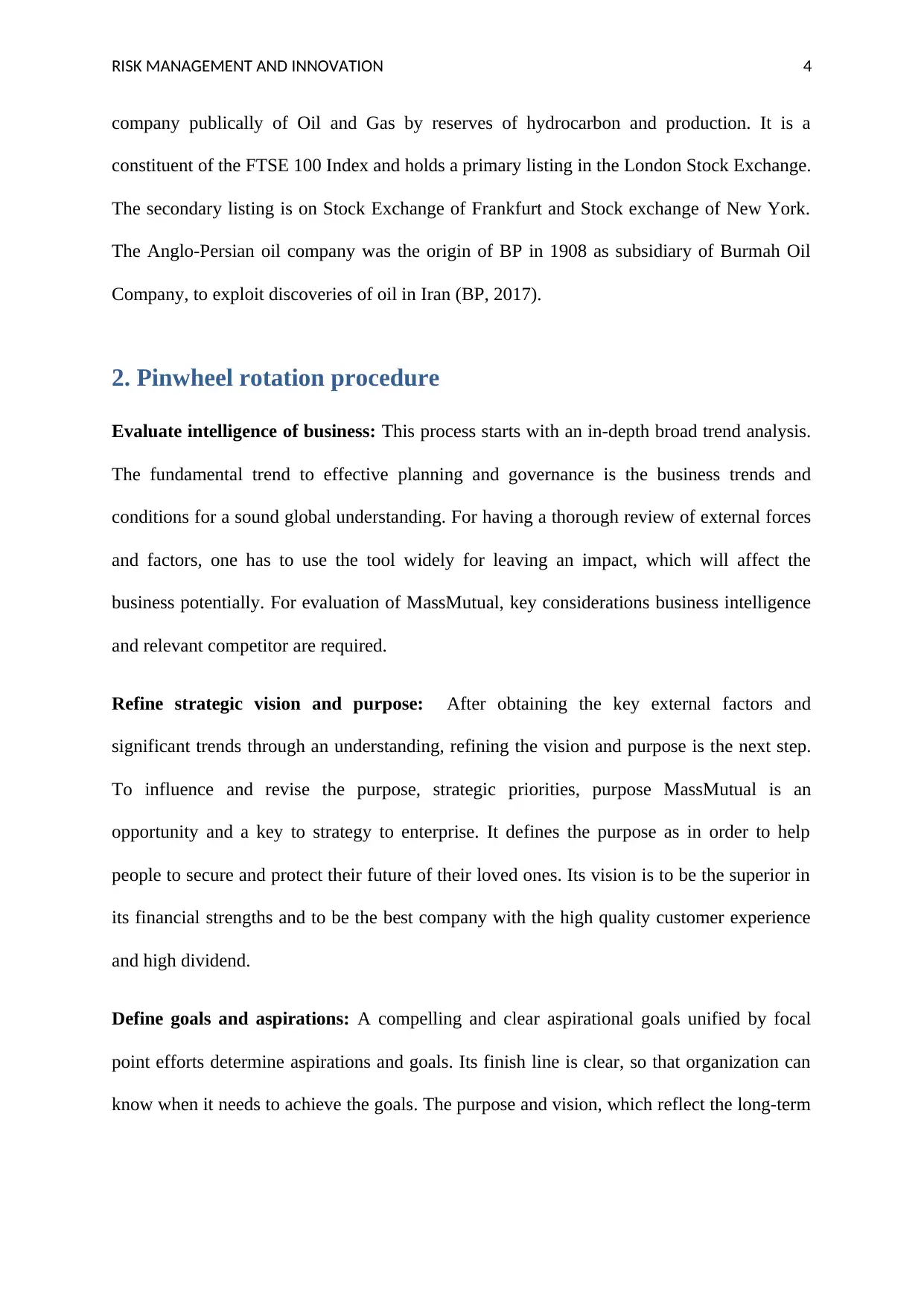
RISK MANAGEMENT AND INNOVATION 4
company publically of Oil and Gas by reserves of hydrocarbon and production. It is a
constituent of the FTSE 100 Index and holds a primary listing in the London Stock Exchange.
The secondary listing is on Stock Exchange of Frankfurt and Stock exchange of New York.
The Anglo-Persian oil company was the origin of BP in 1908 as subsidiary of Burmah Oil
Company, to exploit discoveries of oil in Iran (BP, 2017).
2. Pinwheel rotation procedure
Evaluate intelligence of business: This process starts with an in-depth broad trend analysis.
The fundamental trend to effective planning and governance is the business trends and
conditions for a sound global understanding. For having a thorough review of external forces
and factors, one has to use the tool widely for leaving an impact, which will affect the
business potentially. For evaluation of MassMutual, key considerations business intelligence
and relevant competitor are required.
Refine strategic vision and purpose: After obtaining the key external factors and
significant trends through an understanding, refining the vision and purpose is the next step.
To influence and revise the purpose, strategic priorities, purpose MassMutual is an
opportunity and a key to strategy to enterprise. It defines the purpose as in order to help
people to secure and protect their future of their loved ones. Its vision is to be the superior in
its financial strengths and to be the best company with the high quality customer experience
and high dividend.
Define goals and aspirations: A compelling and clear aspirational goals unified by focal
point efforts determine aspirations and goals. Its finish line is clear, so that organization can
know when it needs to achieve the goals. The purpose and vision, which reflect the long-term
company publically of Oil and Gas by reserves of hydrocarbon and production. It is a
constituent of the FTSE 100 Index and holds a primary listing in the London Stock Exchange.
The secondary listing is on Stock Exchange of Frankfurt and Stock exchange of New York.
The Anglo-Persian oil company was the origin of BP in 1908 as subsidiary of Burmah Oil
Company, to exploit discoveries of oil in Iran (BP, 2017).
2. Pinwheel rotation procedure
Evaluate intelligence of business: This process starts with an in-depth broad trend analysis.
The fundamental trend to effective planning and governance is the business trends and
conditions for a sound global understanding. For having a thorough review of external forces
and factors, one has to use the tool widely for leaving an impact, which will affect the
business potentially. For evaluation of MassMutual, key considerations business intelligence
and relevant competitor are required.
Refine strategic vision and purpose: After obtaining the key external factors and
significant trends through an understanding, refining the vision and purpose is the next step.
To influence and revise the purpose, strategic priorities, purpose MassMutual is an
opportunity and a key to strategy to enterprise. It defines the purpose as in order to help
people to secure and protect their future of their loved ones. Its vision is to be the superior in
its financial strengths and to be the best company with the high quality customer experience
and high dividend.
Define goals and aspirations: A compelling and clear aspirational goals unified by focal
point efforts determine aspirations and goals. Its finish line is clear, so that organization can
know when it needs to achieve the goals. The purpose and vision, which reflect the long-term
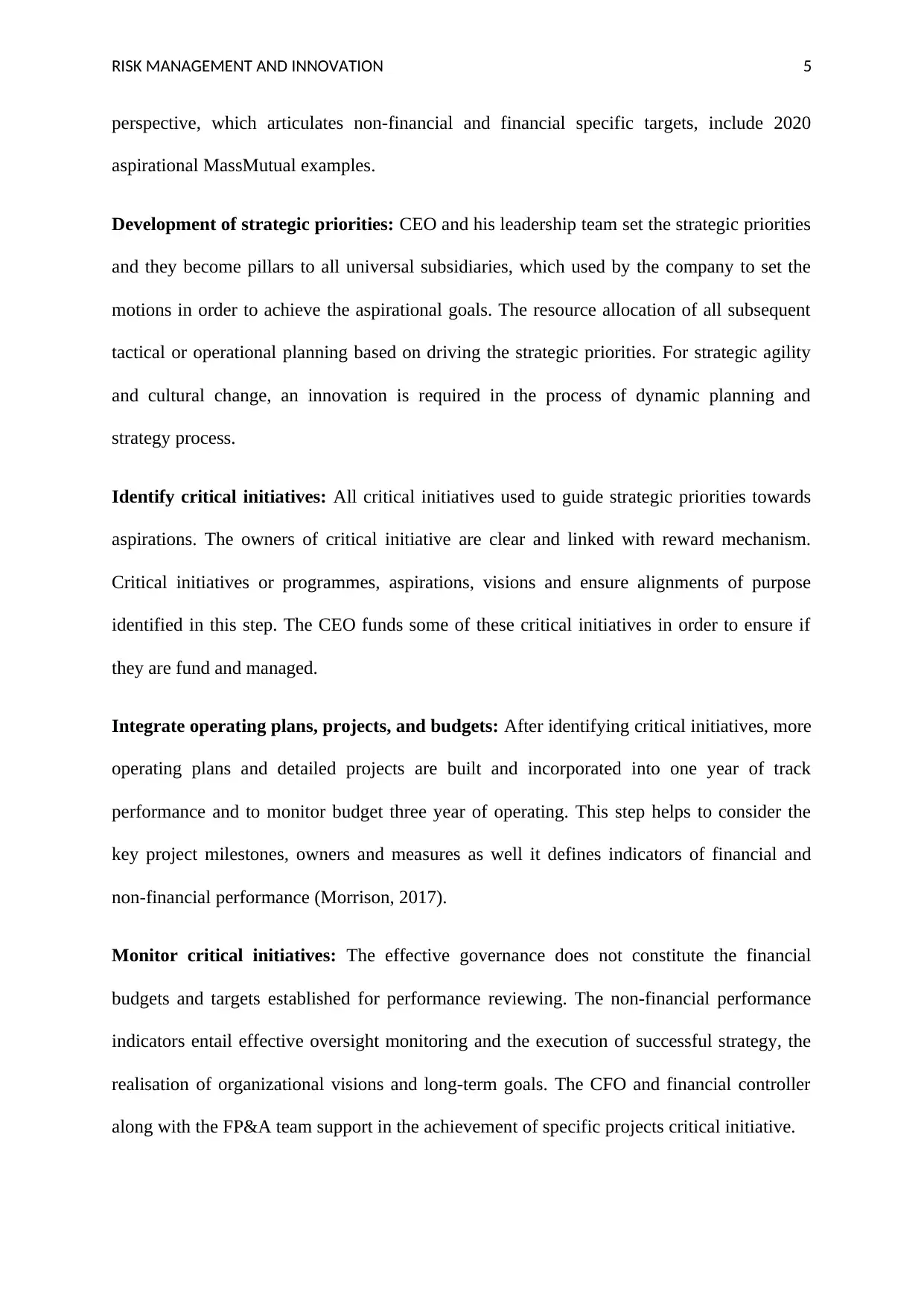
RISK MANAGEMENT AND INNOVATION 5
perspective, which articulates non-financial and financial specific targets, include 2020
aspirational MassMutual examples.
Development of strategic priorities: CEO and his leadership team set the strategic priorities
and they become pillars to all universal subsidiaries, which used by the company to set the
motions in order to achieve the aspirational goals. The resource allocation of all subsequent
tactical or operational planning based on driving the strategic priorities. For strategic agility
and cultural change, an innovation is required in the process of dynamic planning and
strategy process.
Identify critical initiatives: All critical initiatives used to guide strategic priorities towards
aspirations. The owners of critical initiative are clear and linked with reward mechanism.
Critical initiatives or programmes, aspirations, visions and ensure alignments of purpose
identified in this step. The CEO funds some of these critical initiatives in order to ensure if
they are fund and managed.
Integrate operating plans, projects, and budgets: After identifying critical initiatives, more
operating plans and detailed projects are built and incorporated into one year of track
performance and to monitor budget three year of operating. This step helps to consider the
key project milestones, owners and measures as well it defines indicators of financial and
non-financial performance (Morrison, 2017).
Monitor critical initiatives: The effective governance does not constitute the financial
budgets and targets established for performance reviewing. The non-financial performance
indicators entail effective oversight monitoring and the execution of successful strategy, the
realisation of organizational visions and long-term goals. The CFO and financial controller
along with the FP&A team support in the achievement of specific projects critical initiative.
perspective, which articulates non-financial and financial specific targets, include 2020
aspirational MassMutual examples.
Development of strategic priorities: CEO and his leadership team set the strategic priorities
and they become pillars to all universal subsidiaries, which used by the company to set the
motions in order to achieve the aspirational goals. The resource allocation of all subsequent
tactical or operational planning based on driving the strategic priorities. For strategic agility
and cultural change, an innovation is required in the process of dynamic planning and
strategy process.
Identify critical initiatives: All critical initiatives used to guide strategic priorities towards
aspirations. The owners of critical initiative are clear and linked with reward mechanism.
Critical initiatives or programmes, aspirations, visions and ensure alignments of purpose
identified in this step. The CEO funds some of these critical initiatives in order to ensure if
they are fund and managed.
Integrate operating plans, projects, and budgets: After identifying critical initiatives, more
operating plans and detailed projects are built and incorporated into one year of track
performance and to monitor budget three year of operating. This step helps to consider the
key project milestones, owners and measures as well it defines indicators of financial and
non-financial performance (Morrison, 2017).
Monitor critical initiatives: The effective governance does not constitute the financial
budgets and targets established for performance reviewing. The non-financial performance
indicators entail effective oversight monitoring and the execution of successful strategy, the
realisation of organizational visions and long-term goals. The CFO and financial controller
along with the FP&A team support in the achievement of specific projects critical initiative.
⊘ This is a preview!⊘
Do you want full access?
Subscribe today to unlock all pages.

Trusted by 1+ million students worldwide
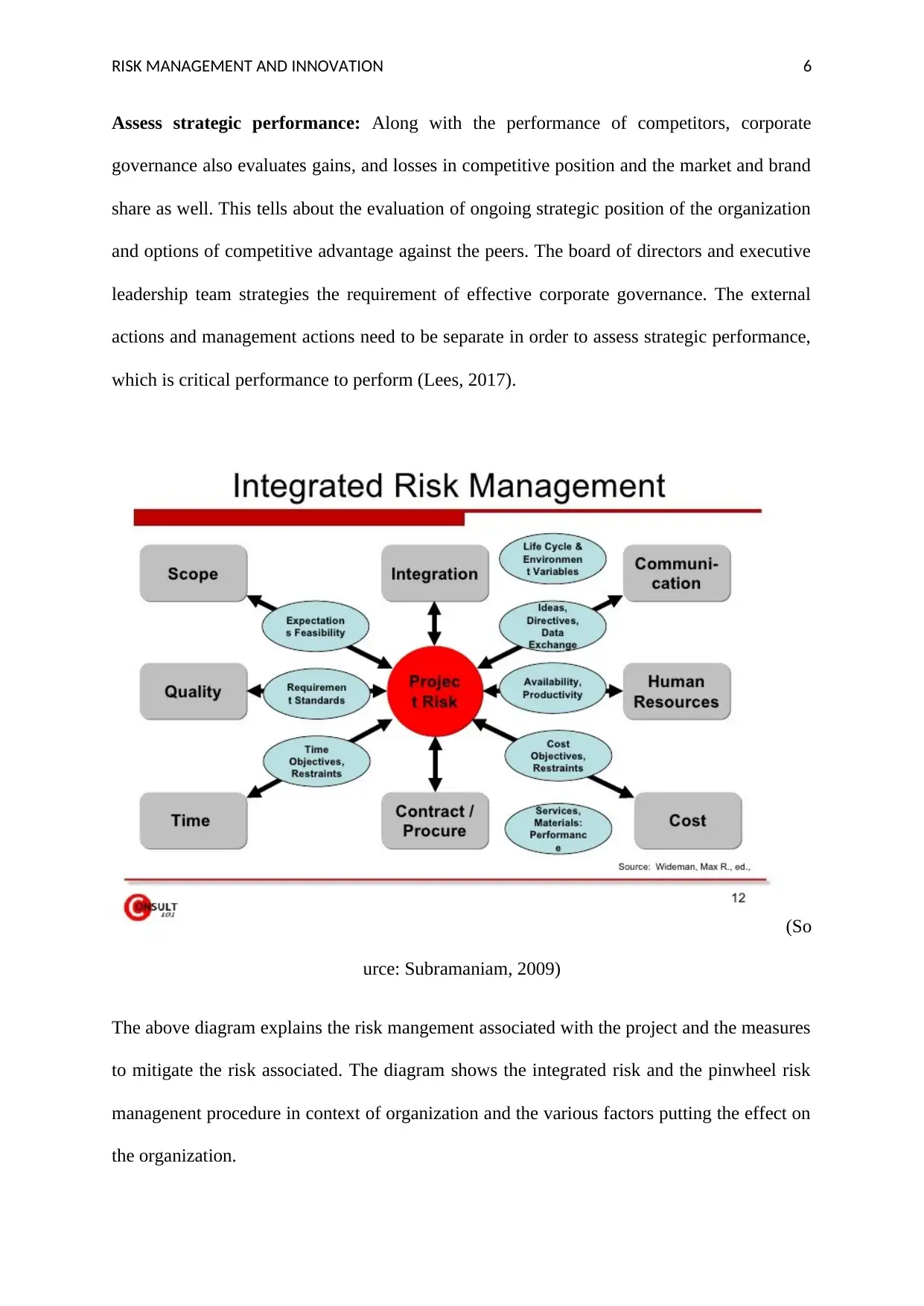
RISK MANAGEMENT AND INNOVATION 6
Assess strategic performance: Along with the performance of competitors, corporate
governance also evaluates gains, and losses in competitive position and the market and brand
share as well. This tells about the evaluation of ongoing strategic position of the organization
and options of competitive advantage against the peers. The board of directors and executive
leadership team strategies the requirement of effective corporate governance. The external
actions and management actions need to be separate in order to assess strategic performance,
which is critical performance to perform (Lees, 2017).
(So
urce: Subramaniam, 2009)
The above diagram explains the risk mangement associated with the project and the measures
to mitigate the risk associated. The diagram shows the integrated risk and the pinwheel risk
managenent procedure in context of organization and the various factors putting the effect on
the organization.
Assess strategic performance: Along with the performance of competitors, corporate
governance also evaluates gains, and losses in competitive position and the market and brand
share as well. This tells about the evaluation of ongoing strategic position of the organization
and options of competitive advantage against the peers. The board of directors and executive
leadership team strategies the requirement of effective corporate governance. The external
actions and management actions need to be separate in order to assess strategic performance,
which is critical performance to perform (Lees, 2017).
(So
urce: Subramaniam, 2009)
The above diagram explains the risk mangement associated with the project and the measures
to mitigate the risk associated. The diagram shows the integrated risk and the pinwheel risk
managenent procedure in context of organization and the various factors putting the effect on
the organization.
Paraphrase This Document
Need a fresh take? Get an instant paraphrase of this document with our AI Paraphraser
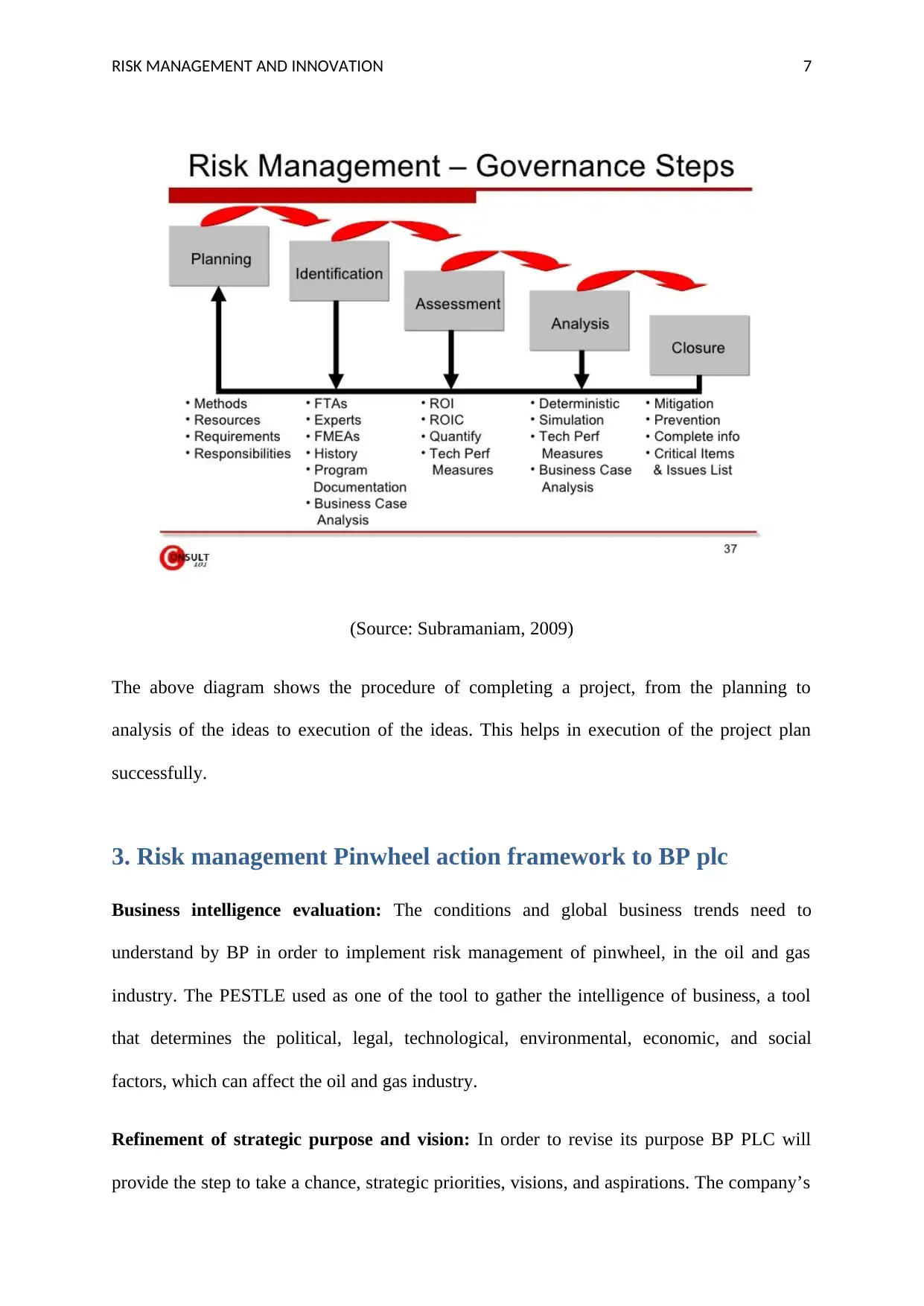
RISK MANAGEMENT AND INNOVATION 7
(Source: Subramaniam, 2009)
The above diagram shows the procedure of completing a project, from the planning to
analysis of the ideas to execution of the ideas. This helps in execution of the project plan
successfully.
3. Risk management Pinwheel action framework to BP plc
Business intelligence evaluation: The conditions and global business trends need to
understand by BP in order to implement risk management of pinwheel, in the oil and gas
industry. The PESTLE used as one of the tool to gather the intelligence of business, a tool
that determines the political, legal, technological, environmental, economic, and social
factors, which can affect the oil and gas industry.
Refinement of strategic purpose and vision: In order to revise its purpose BP PLC will
provide the step to take a chance, strategic priorities, visions, and aspirations. The company’s
(Source: Subramaniam, 2009)
The above diagram shows the procedure of completing a project, from the planning to
analysis of the ideas to execution of the ideas. This helps in execution of the project plan
successfully.
3. Risk management Pinwheel action framework to BP plc
Business intelligence evaluation: The conditions and global business trends need to
understand by BP in order to implement risk management of pinwheel, in the oil and gas
industry. The PESTLE used as one of the tool to gather the intelligence of business, a tool
that determines the political, legal, technological, environmental, economic, and social
factors, which can affect the oil and gas industry.
Refinement of strategic purpose and vision: In order to revise its purpose BP PLC will
provide the step to take a chance, strategic priorities, visions, and aspirations. The company’s
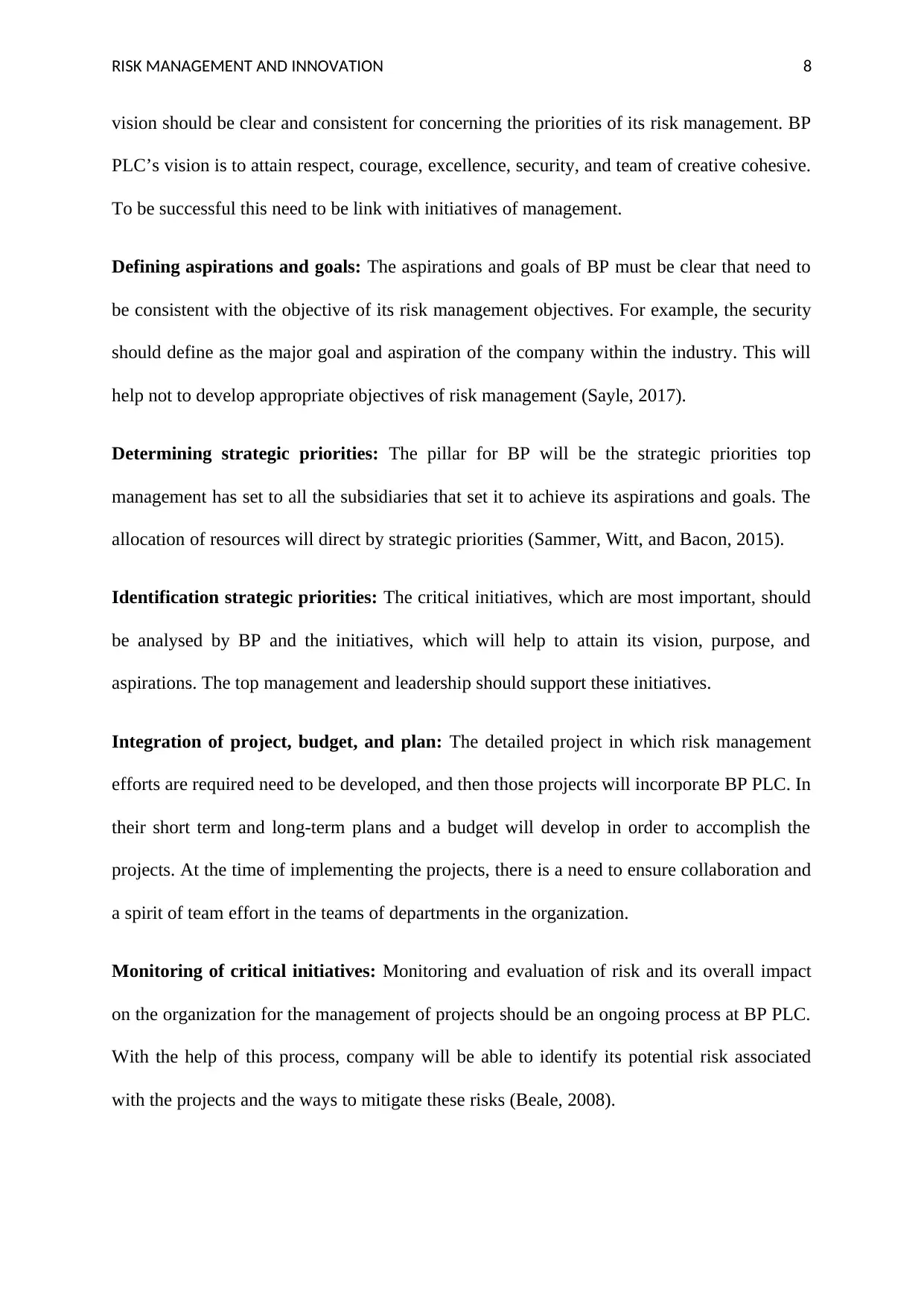
RISK MANAGEMENT AND INNOVATION 8
vision should be clear and consistent for concerning the priorities of its risk management. BP
PLC’s vision is to attain respect, courage, excellence, security, and team of creative cohesive.
To be successful this need to be link with initiatives of management.
Defining aspirations and goals: The aspirations and goals of BP must be clear that need to
be consistent with the objective of its risk management objectives. For example, the security
should define as the major goal and aspiration of the company within the industry. This will
help not to develop appropriate objectives of risk management (Sayle, 2017).
Determining strategic priorities: The pillar for BP will be the strategic priorities top
management has set to all the subsidiaries that set it to achieve its aspirations and goals. The
allocation of resources will direct by strategic priorities (Sammer, Witt, and Bacon, 2015).
Identification strategic priorities: The critical initiatives, which are most important, should
be analysed by BP and the initiatives, which will help to attain its vision, purpose, and
aspirations. The top management and leadership should support these initiatives.
Integration of project, budget, and plan: The detailed project in which risk management
efforts are required need to be developed, and then those projects will incorporate BP PLC. In
their short term and long-term plans and a budget will develop in order to accomplish the
projects. At the time of implementing the projects, there is a need to ensure collaboration and
a spirit of team effort in the teams of departments in the organization.
Monitoring of critical initiatives: Monitoring and evaluation of risk and its overall impact
on the organization for the management of projects should be an ongoing process at BP PLC.
With the help of this process, company will be able to identify its potential risk associated
with the projects and the ways to mitigate these risks (Beale, 2008).
vision should be clear and consistent for concerning the priorities of its risk management. BP
PLC’s vision is to attain respect, courage, excellence, security, and team of creative cohesive.
To be successful this need to be link with initiatives of management.
Defining aspirations and goals: The aspirations and goals of BP must be clear that need to
be consistent with the objective of its risk management objectives. For example, the security
should define as the major goal and aspiration of the company within the industry. This will
help not to develop appropriate objectives of risk management (Sayle, 2017).
Determining strategic priorities: The pillar for BP will be the strategic priorities top
management has set to all the subsidiaries that set it to achieve its aspirations and goals. The
allocation of resources will direct by strategic priorities (Sammer, Witt, and Bacon, 2015).
Identification strategic priorities: The critical initiatives, which are most important, should
be analysed by BP and the initiatives, which will help to attain its vision, purpose, and
aspirations. The top management and leadership should support these initiatives.
Integration of project, budget, and plan: The detailed project in which risk management
efforts are required need to be developed, and then those projects will incorporate BP PLC. In
their short term and long-term plans and a budget will develop in order to accomplish the
projects. At the time of implementing the projects, there is a need to ensure collaboration and
a spirit of team effort in the teams of departments in the organization.
Monitoring of critical initiatives: Monitoring and evaluation of risk and its overall impact
on the organization for the management of projects should be an ongoing process at BP PLC.
With the help of this process, company will be able to identify its potential risk associated
with the projects and the ways to mitigate these risks (Beale, 2008).
⊘ This is a preview!⊘
Do you want full access?
Subscribe today to unlock all pages.

Trusted by 1+ million students worldwide
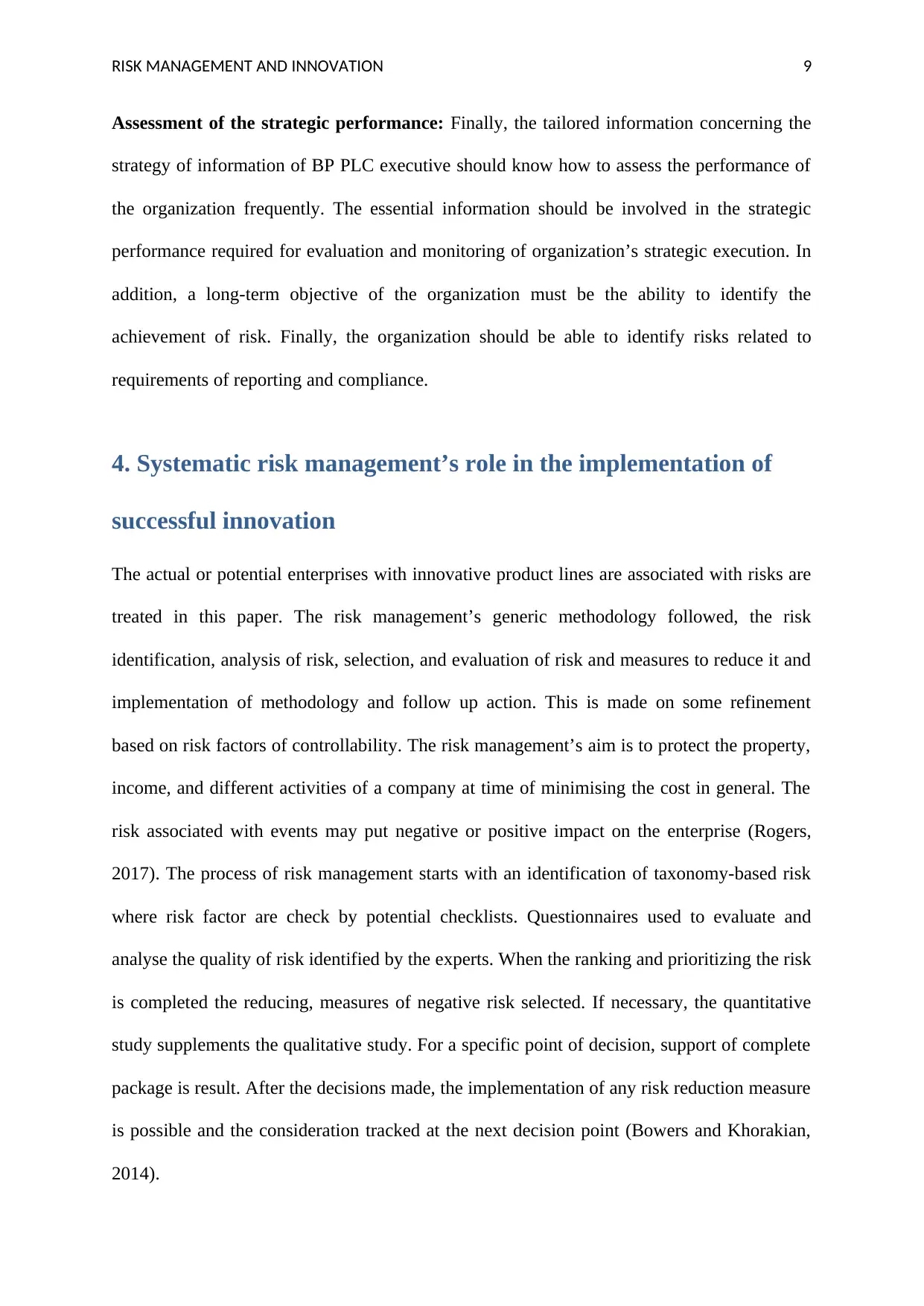
RISK MANAGEMENT AND INNOVATION 9
Assessment of the strategic performance: Finally, the tailored information concerning the
strategy of information of BP PLC executive should know how to assess the performance of
the organization frequently. The essential information should be involved in the strategic
performance required for evaluation and monitoring of organization’s strategic execution. In
addition, a long-term objective of the organization must be the ability to identify the
achievement of risk. Finally, the organization should be able to identify risks related to
requirements of reporting and compliance.
4. Systematic risk management’s role in the implementation of
successful innovation
The actual or potential enterprises with innovative product lines are associated with risks are
treated in this paper. The risk management’s generic methodology followed, the risk
identification, analysis of risk, selection, and evaluation of risk and measures to reduce it and
implementation of methodology and follow up action. This is made on some refinement
based on risk factors of controllability. The risk management’s aim is to protect the property,
income, and different activities of a company at time of minimising the cost in general. The
risk associated with events may put negative or positive impact on the enterprise (Rogers,
2017). The process of risk management starts with an identification of taxonomy-based risk
where risk factor are check by potential checklists. Questionnaires used to evaluate and
analyse the quality of risk identified by the experts. When the ranking and prioritizing the risk
is completed the reducing, measures of negative risk selected. If necessary, the quantitative
study supplements the qualitative study. For a specific point of decision, support of complete
package is result. After the decisions made, the implementation of any risk reduction measure
is possible and the consideration tracked at the next decision point (Bowers and Khorakian,
2014).
Assessment of the strategic performance: Finally, the tailored information concerning the
strategy of information of BP PLC executive should know how to assess the performance of
the organization frequently. The essential information should be involved in the strategic
performance required for evaluation and monitoring of organization’s strategic execution. In
addition, a long-term objective of the organization must be the ability to identify the
achievement of risk. Finally, the organization should be able to identify risks related to
requirements of reporting and compliance.
4. Systematic risk management’s role in the implementation of
successful innovation
The actual or potential enterprises with innovative product lines are associated with risks are
treated in this paper. The risk management’s generic methodology followed, the risk
identification, analysis of risk, selection, and evaluation of risk and measures to reduce it and
implementation of methodology and follow up action. This is made on some refinement
based on risk factors of controllability. The risk management’s aim is to protect the property,
income, and different activities of a company at time of minimising the cost in general. The
risk associated with events may put negative or positive impact on the enterprise (Rogers,
2017). The process of risk management starts with an identification of taxonomy-based risk
where risk factor are check by potential checklists. Questionnaires used to evaluate and
analyse the quality of risk identified by the experts. When the ranking and prioritizing the risk
is completed the reducing, measures of negative risk selected. If necessary, the quantitative
study supplements the qualitative study. For a specific point of decision, support of complete
package is result. After the decisions made, the implementation of any risk reduction measure
is possible and the consideration tracked at the next decision point (Bowers and Khorakian,
2014).
Paraphrase This Document
Need a fresh take? Get an instant paraphrase of this document with our AI Paraphraser
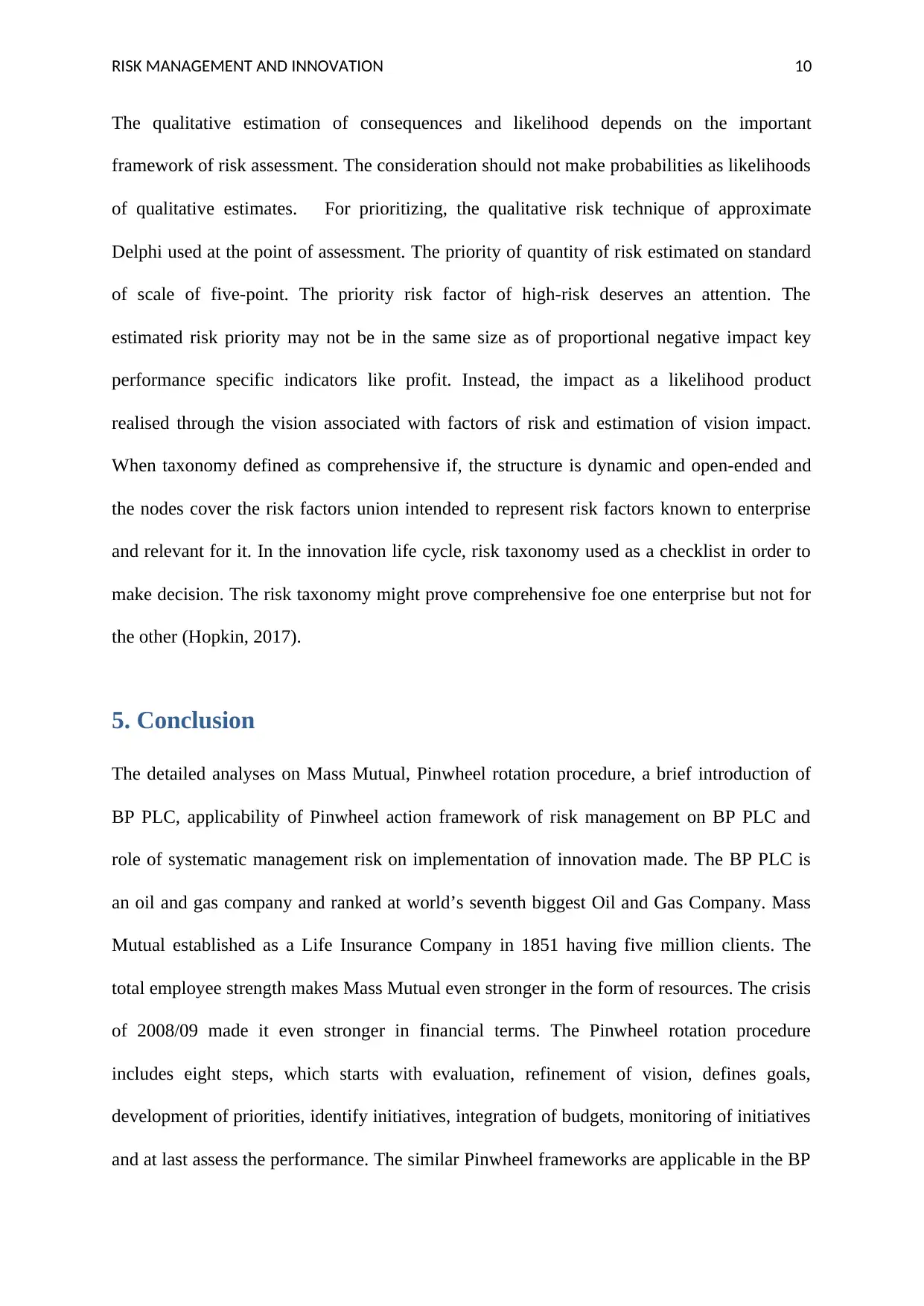
RISK MANAGEMENT AND INNOVATION 10
The qualitative estimation of consequences and likelihood depends on the important
framework of risk assessment. The consideration should not make probabilities as likelihoods
of qualitative estimates. For prioritizing, the qualitative risk technique of approximate
Delphi used at the point of assessment. The priority of quantity of risk estimated on standard
of scale of five-point. The priority risk factor of high-risk deserves an attention. The
estimated risk priority may not be in the same size as of proportional negative impact key
performance specific indicators like profit. Instead, the impact as a likelihood product
realised through the vision associated with factors of risk and estimation of vision impact.
When taxonomy defined as comprehensive if, the structure is dynamic and open-ended and
the nodes cover the risk factors union intended to represent risk factors known to enterprise
and relevant for it. In the innovation life cycle, risk taxonomy used as a checklist in order to
make decision. The risk taxonomy might prove comprehensive foe one enterprise but not for
the other (Hopkin, 2017).
5. Conclusion
The detailed analyses on Mass Mutual, Pinwheel rotation procedure, a brief introduction of
BP PLC, applicability of Pinwheel action framework of risk management on BP PLC and
role of systematic management risk on implementation of innovation made. The BP PLC is
an oil and gas company and ranked at world’s seventh biggest Oil and Gas Company. Mass
Mutual established as a Life Insurance Company in 1851 having five million clients. The
total employee strength makes Mass Mutual even stronger in the form of resources. The crisis
of 2008/09 made it even stronger in financial terms. The Pinwheel rotation procedure
includes eight steps, which starts with evaluation, refinement of vision, defines goals,
development of priorities, identify initiatives, integration of budgets, monitoring of initiatives
and at last assess the performance. The similar Pinwheel frameworks are applicable in the BP
The qualitative estimation of consequences and likelihood depends on the important
framework of risk assessment. The consideration should not make probabilities as likelihoods
of qualitative estimates. For prioritizing, the qualitative risk technique of approximate
Delphi used at the point of assessment. The priority of quantity of risk estimated on standard
of scale of five-point. The priority risk factor of high-risk deserves an attention. The
estimated risk priority may not be in the same size as of proportional negative impact key
performance specific indicators like profit. Instead, the impact as a likelihood product
realised through the vision associated with factors of risk and estimation of vision impact.
When taxonomy defined as comprehensive if, the structure is dynamic and open-ended and
the nodes cover the risk factors union intended to represent risk factors known to enterprise
and relevant for it. In the innovation life cycle, risk taxonomy used as a checklist in order to
make decision. The risk taxonomy might prove comprehensive foe one enterprise but not for
the other (Hopkin, 2017).
5. Conclusion
The detailed analyses on Mass Mutual, Pinwheel rotation procedure, a brief introduction of
BP PLC, applicability of Pinwheel action framework of risk management on BP PLC and
role of systematic management risk on implementation of innovation made. The BP PLC is
an oil and gas company and ranked at world’s seventh biggest Oil and Gas Company. Mass
Mutual established as a Life Insurance Company in 1851 having five million clients. The
total employee strength makes Mass Mutual even stronger in the form of resources. The crisis
of 2008/09 made it even stronger in financial terms. The Pinwheel rotation procedure
includes eight steps, which starts with evaluation, refinement of vision, defines goals,
development of priorities, identify initiatives, integration of budgets, monitoring of initiatives
and at last assess the performance. The similar Pinwheel frameworks are applicable in the BP
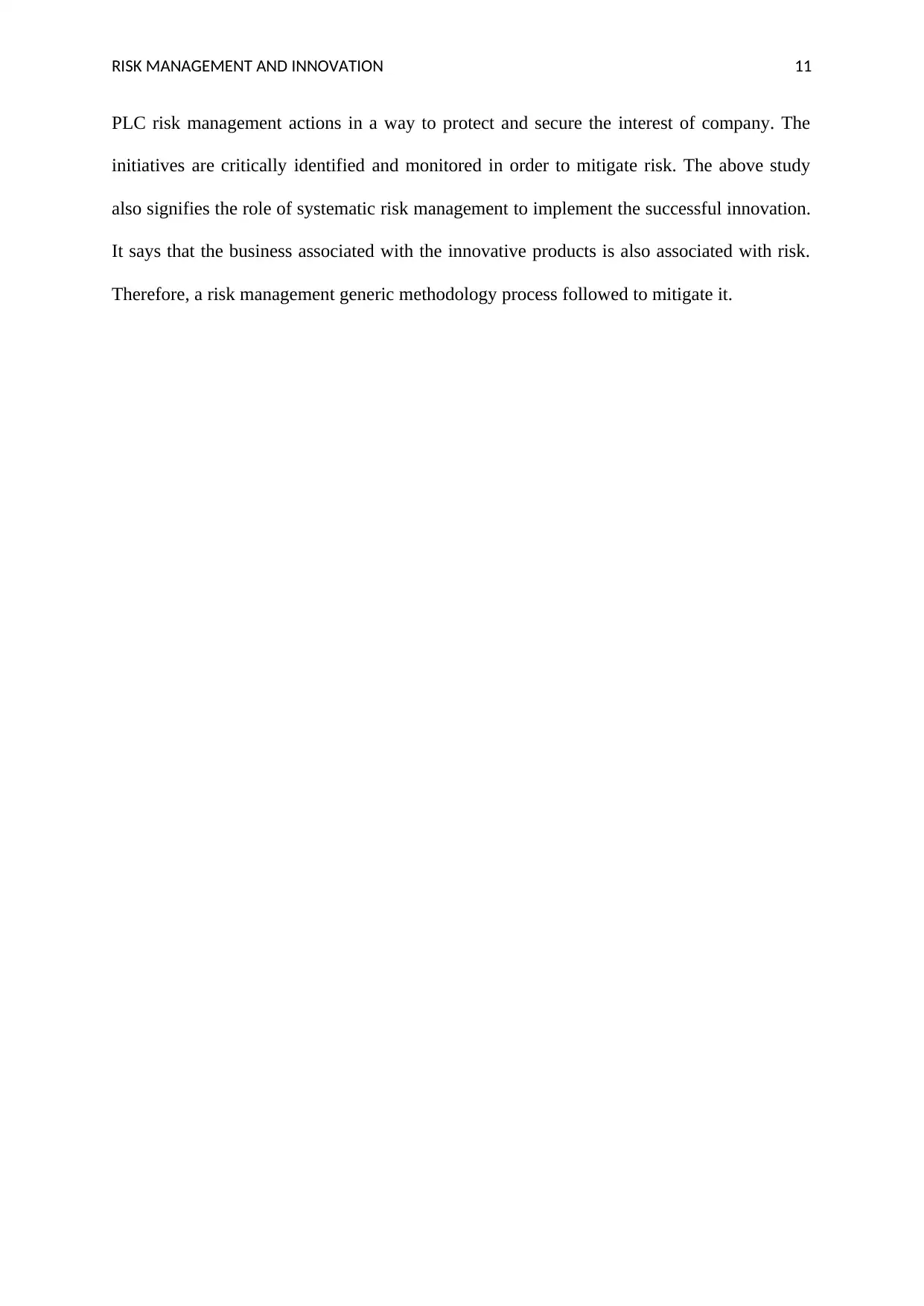
RISK MANAGEMENT AND INNOVATION 11
PLC risk management actions in a way to protect and secure the interest of company. The
initiatives are critically identified and monitored in order to mitigate risk. The above study
also signifies the role of systematic risk management to implement the successful innovation.
It says that the business associated with the innovative products is also associated with risk.
Therefore, a risk management generic methodology process followed to mitigate it.
PLC risk management actions in a way to protect and secure the interest of company. The
initiatives are critically identified and monitored in order to mitigate risk. The above study
also signifies the role of systematic risk management to implement the successful innovation.
It says that the business associated with the innovative products is also associated with risk.
Therefore, a risk management generic methodology process followed to mitigate it.
⊘ This is a preview!⊘
Do you want full access?
Subscribe today to unlock all pages.

Trusted by 1+ million students worldwide
1 out of 14
Related Documents
Your All-in-One AI-Powered Toolkit for Academic Success.
+13062052269
info@desklib.com
Available 24*7 on WhatsApp / Email
![[object Object]](/_next/static/media/star-bottom.7253800d.svg)
Unlock your academic potential
Copyright © 2020–2025 A2Z Services. All Rights Reserved. Developed and managed by ZUCOL.




